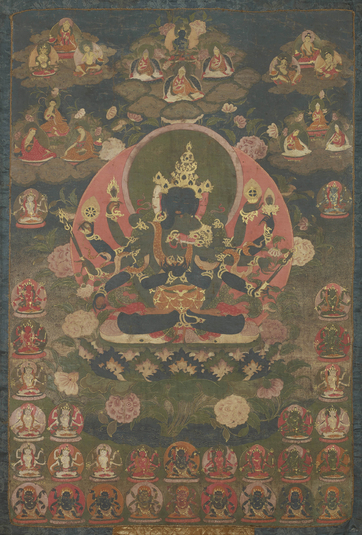
Item: Guhyasamaja (Buddhist Deity) - Akshobhyavajra
| Origin Location | Tibet |
|---|---|
| Date Range | 1700 - 1799 |
| Lineages | Gelug and Buddhist |
| Material | Ground Mineral Pigment on Cotton |
| Collection | Private |
Akshobhyavajra, Guhyasamaja (Tibetan: mi kyo dor je, sang wa du pa. English: the Unshakable Scepter, Secret Assembly): principle deity of the Father (Method) classification of Anuttarayoga Tantra.
Guhyasamaja is one of the principal meditational deities of Vajrayana Buddhism (Tantra). The practice is foundational for Tantric theory for all the 'new' (sarma) schools of Tibetan Buddhism. Painted compositions such as this are illustrative of all the figures represented in the practice along with a selection of lineage teachers which are seen at the top of the painting. The proper formalised ritual image for the practice for Guhyasamaja is understood through the model of the container and the contained which is the mandala of the deity, retinue and the palace and surroundings.
At the top center is Buddha Vajradhara, blue in colour, accompanied by three monastic figures wearing yellow pandita hats. At the top left is the Indian king Indrabhuti along with Nagadevi and Saraha holding an arrow. Below that is Arya Nagarjuna and two Indian scholars.
At the to right side are three Indian siddhas. Below that are Je Tsongkhapa, Khedrub and Pagpalha.
Akshobhyavajra Guhyasamaja Description: "...with a body blue in colour like sapphire, issuing forth rays of blazing light. The main face is blue with a mixed expression of fierceness and desire. The canine teeth are pointed and clenched, frowning and having three eyes. The right face is white in a peaceful manner, left face is red in a desirous manner. All three faces are adorned with very beautiful eyebrows. Each of the six hands are adorned with precious rings. The first two hands hold a nine pointed vajra and a bell embracing the consort [who is in] the same [appearance] as the [Father]. The right second [hand] holds a white wheel with eight spokes. The third [hand] holds a red lotus with eight petals. The left second [hand] holds a green jewel with nine facets. The third [hand] holds a sword, bright blue and blazing with rays of light. Seated with the legs in vajra posture, adorned with the thirty-two major and eighty minor marks, the hair, in braids, is tied on the crown of the head. The jewel on the crown of the head greatly blazes with soothing rays of light [like] the sun and moon. Adorned with eight [different types] of precious ornaments: a crown, earrings, choker, necklace, armlets, bracelets, long necklace and belt. The ears are made more beautiful with blue utpalas and ribbons; wearing various [heavenly] garments bright like Indra's bow [rainbow]." (Jamgon Amezhab, 1597-1659).
At the sides and below are twenty peaceful figures, three faces, six arms, seated, in a a variety of colours. In the bottom register are the ten wrathful ones of the outer mandala of Guhyasamaja. In totals, counting the central couple, there are thirty-two deities.
Guhyasamaja Akshobhyavajra Lineage, with the Thirty-two Deity Mandala, Abhisheka, Tantra and Sadhana together with its Branches: Vajradhara, Vajrapani, Acharya Nagarjuna, Aryadeva, Shakya Shenyen, Chandrakirti, Rolpai Dorje, Kalden Dragpai Odzer Jungne Dragpa, Odze Deva, Chokyi Jungne Shiwa, Choje Panchen Shakya Shri, Choje Sakya Pandita, Lama Chokyi Gyalpo (Chogyal Pagpa 1235-1280).
Guhyasamaja (Secret Assembly) is a Buddhist meditational deity that arises from the Guhyasamaja root text Sarva Tathagata Kaya Vag Chitta Rahasya Guhyasamaja Nama Maha Kalpa Raja Tantra (4th-5th century C.E.). There are three principal forms of the deity; Akshobhyavajra (Unshakable Vajra), Manjuvajra (Melodious Speech Vajra) and Lokeshvara (Lord of the World). The Manjuvajra form arises from a separate text, Shri Vajra Hridaya Lamkara Tantra-nama, related to the root tantra. The first two forms, Akshobhya and Manjuvajra, come down primarily through the three lineages of Acharya Abhayakaragupta, Nyen Lotsawa and Marpa Lotsawa. The red Lokeshvara form was popularized by Atisha Dipamkara. View a 3-dimensional paper model of the Guhyasamaja mandala. Some glosses on the Guhyasamaja by Giuseppe Tucci from Melanges Chinois et Bouddhiques, Vol.3. 1934-35, P.339-353.
The composition has elements of the New Menri painting style of central Tibet such as the dark border around some of the cloud elements and the large flowers surrounding the halo of the two central figures. The dark blue open sky above and the green landscape in the foreground with minimal decoration is more indicative of the looser and less condensed style popular in the Kham Province of East Tibet.
Jeff Watt 2-2018
Front of Painting
English Translation of Inscription: [Name inscriptions]
Buddhist Deity: Guhyasamaja Main Page
Buddhist Deity: Guhyasamaja, Akshobhyavajra
Buddhist Deity: Guhyasamaja - Akshobhyavajra (Deity & Retinue)
Collection of Anna Maria Rossi & Fabio Rossi

